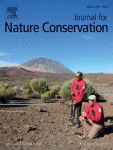Ver ítem
- xmlui.general.dspace_homeCentros Regionales y EEAsCentro Regional Buenos Aires SurEEA Cuenca del SaladoArtículos científicosxmlui.ArtifactBrowser.ItemViewer.trail
- Inicio
- Centros Regionales y EEAs
- Centro Regional Buenos Aires Sur
- EEA Cuenca del Salado
- Artículos científicos
- Ver ítem
Short-term plant community response to grassland management intended to improve forage quality for the endangered Pampas deer
Resumen
The Pampas deer is a medium-sized neotropical cervid whose population has been affected by the advancement of the agricultural frontier, poaching and depredation by introduced species. As a consequence, the population of the deer has dramatically decreased and its distribution has contracted. At present, Samborombón Bay remains one of the last populations of this deer in Argentina. The management of natural pastures to improve forage quality is one of the
[ver mas...]
The Pampas deer is a medium-sized neotropical cervid whose population has been affected by the advancement of the agricultural frontier, poaching and depredation by introduced species. As a consequence, the population of the deer has dramatically decreased and its distribution has contracted. At present, Samborombón Bay remains one of the last populations of this deer in Argentina. The management of natural pastures to improve forage quality is one of the policies adopted by authorities at this site for the conservation of this cervid species. In this study, we assessed the efficacy of grassland management practices (burning and cutting) to promote better forage quality for Pampas deer. The work was carried out in the Campos del Tuyú National Park where two plots were managed to improve the available natural pastures. These plots were burned at the beginning of autumn and intensely defoliated at the end of spring, followed by mechanical cuts in the following autumn and late spring. Multivariate analyses revealed that structure and composition varied between treatments. Green biomass, total plant cover, and forage quality of grasses increased in the plots under management for winter pastures, although no significant differences were detected between summer pastures. The results indicate that grassland management would be a useful tool to improve habitat quality for Pampas deer; however, managed grassland also lost structural heterogeneity. Despite the fact that this study reveals a short-time response of grassland to management, our study shows promising results to continue and expand this practice for the improvement of the habitat quality for Pampas deers.
[Cerrar]

Autor
Carro, Mariana Emilia;
Casal, Alejandra Veronica;
Coria, Juan Daniel;
Fernández, Gustavo Javier;
Beade, Mario S.;
Fuente
Journal for Nature Conservation 50 : 125716 (August 2019)
Fecha
2019-08
Editorial
Elsevier
ISSN
1617-1381
Formato
pdf
Tipo de documento
artículo
Palabras Claves
Derechos de acceso
Restringido
 Excepto donde se diga explicitamente, este item se publica bajo la siguiente descripción: Creative Commons Attribution-NonCommercial-ShareAlike 2.5 Unported (CC BY-NC-SA 2.5)
Excepto donde se diga explicitamente, este item se publica bajo la siguiente descripción: Creative Commons Attribution-NonCommercial-ShareAlike 2.5 Unported (CC BY-NC-SA 2.5)

